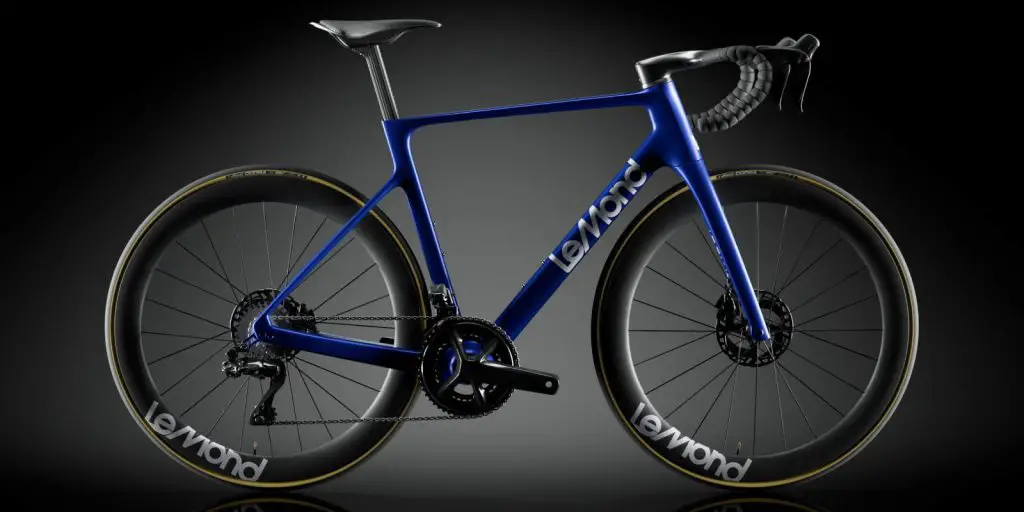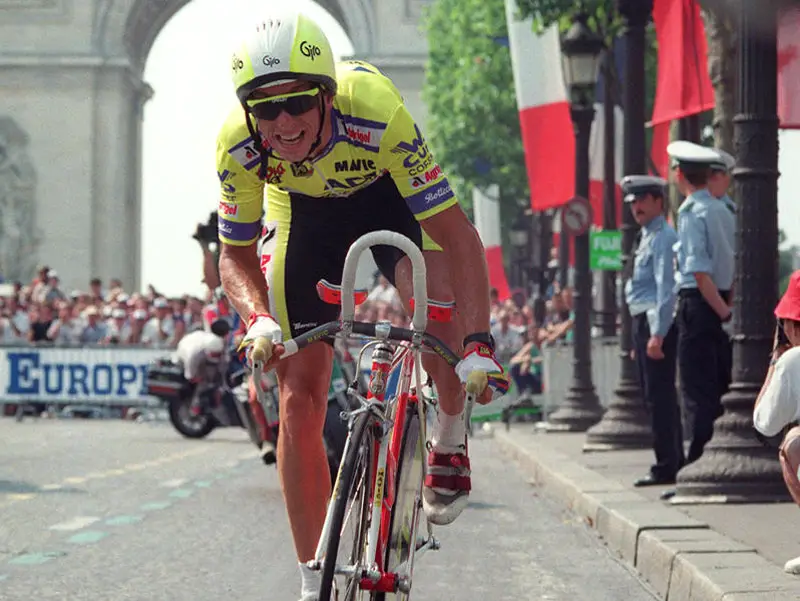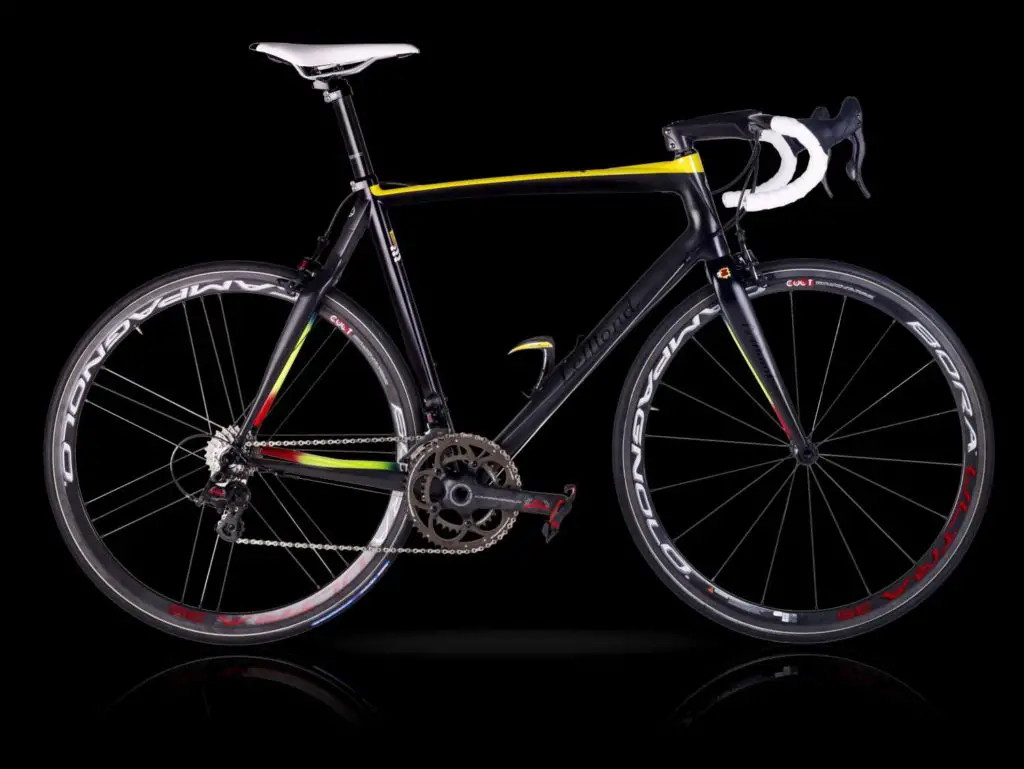According to reports, Greg LeMond is going to successfully revive his bike brand: he recently raised a bit over $2 million in a private placement investment. In collaboration with Deakin University, new LeMond bikes will use the technology developed by Greg LeMond’s other business, LeMond Carbon.
Back in 2013, triple Tour de France winner (and the only American winner of the French grand tour) Greg LeMond launched three limited-edition road bikes produced in collaboration with the French bicycle manufacturer Time. These three bikes were named after the years of his Tour de France victories: TDF 1986, TDF 1989, and TDF 1990.
Many retired pro cyclists set up their own brand of bicycles after the end of their career: Cino Cinelli, Ernesto Colnago, Giovanni Pinarello, Eddy Merckx, Mario Cipollini, to name a few.
Now comes the ultralight Abikes, in which Alberto Contador and Ivan Basso have joined forces. Greg LeMond, on the other hand, founded his bike brand even before retirement, during his career, when he was racing for the Z-Tomasso team in 1990 and 1991.
Now, LeMond bikes are returning back and this time, the brand will have its own production facilities. It was also announced that the new LeMond bikes are expected to be produced cheaper than the competition in the United States.
According to reports, LeMond Bicycles LLC recently raised a bit over $2 million in a private placement investment, possibly bringing the company closer to launching a bike line using technology developed by Greg LeMond’s other business, LeMond Carbon.


Related: LeMond 8 Concept
Greg LeMond unveiled the LeMond 8 concept road bike. It’s US-made, and the producer claims it represents the biggest development in carbon fiber frames in 30 years! The new bicycle’s name is a reference to Greg Lemond’s 1989 Tour de France victory, when he won the race by just 8 seconds, the closest winning margin in history.
Greg LeMond has always been associated with carbon
During his career, LeMond championed several technological advancements in pro cycling, including the introduction of aerodynamic “triathlon” handlebars and carbon fiber bicycle frames. Many boasts of being a pioneer in carbon frames, but one thing is clear: the first to win the Carbon Frame Tour was Greg LeMond back in 1986 – and the second-finisher in that Tour de France was his teammate Bernard Hinault, who rode the same LOOK model KG 86.
Marginal gains were not as important in the 1980s as they are today. But not for Greg LeMond who has always been looking for improvements: In 1989, he won the Tour de France thanks to aerodynamic improvements: he used aerobars and an aerodynamic helmet while storming to win the 1989 Tour with just eight seconds. It was the fastest time-trial performance ever in the Tour’s history, and it remained so until Rohan Dennis set a new record in Tour de France 2015.
At the time, aerobars and aerodynamic helmets were ridiculed, but now they are the standard – which cannot be said for ordinary prescription glasses and long hair tied in a ponytail, with which the defeated Laurent Fignon presented himself on that decisive Time-Trial stage from Versailles to the Champs Elysees.

Related: Eight Seconds
1989 edition of Tour de France won by Greg LeMond with the narrowest margin in its history: eight seconds.
Greg LeMond founded LeMond Composites in 2016 to manufacture high-volume, low-cost carbon fiber composites under a licensing agreement with the Oak Ridge National Laboratory and an exclusive 20-year licensing agreement with Deakin University.
It now appears that LeMond, with its company LeMond Composites – which is separate from LeMond Racing Cycles – is once again breaking new ground, this time in the field of carbon fiber production. The American media Composites Today reported that the auditors of the independent company Bureau Veritas confirmed that the processes of carbon fiber production in the factory in Tennessee and tests of composites are successful. What does that mean?
A better, and cheaper carbon fiber production technology
Maybe that carbon frames will get cheaper. Greg LeMond said:
‘This is a significant milestone for our company. Having our technology independently verified by BV validates the revolutionary nature of our technology.”
“My team and I are excited to bring our high-performance low-cost carbon fiber to the global market, and look forward to expanding into new markets where the current high cost of carbon fiber has been a significant barrier to adoption.”
“Deakin has always been excited about the potential of our patented new technology and it is encouraging to receive independent validation that our technology is effective at scale.”
The development, in collaboration with Deakin University in Australia, took three years, and the new process is expected to produce carbon fiber four times faster than it is now, using 75 percent less energy and reducing production by 30 to 60 percent. Cheaper carbon fiber would thus make production cheaper in many industries, including cycling.
This could mean, in the near future, the production of carbon bicycle frames will move from Asia to the United States.
When we’ll see the new LeMond bicycles?
We don’t know yet. Now, the LeMond Racing Cycles website (lemond.cc) doesn’t show any information – the company has a new logo, though. You can only “join the waitlist”.
The first spring presentations were probably delayed by the corona crisis, but they are now announcing the first presentations in early August. Photos appeared in January don’t say much.
A short history of LeMond racing cycles
In 1990, LeMond founded LeMond Bicycles to develop machines for himself that would also be marketed and sold to the public. LeMond bikes have always been popular, but apparently the main problem was that the three-time Tour winner didn’t have its own production facilities. The frame of the Greg LeMond bike which he rode winning the 1991 Tour de France was a product of the American company Carbonframes, Inc., (Calfee Design). It was the first all-carbon fiber frameset to be raced in the Tour de France.
Despite the best possible promotion, the company eventually faltered, something LeMond blamed on “under-capitalization” and poor management by his father. Carbonframes, Inc. and LeMond Cycles “parted amicably” two years later.
In 1995, immediately after the end of his brilliant racing career, LeMond entered into a partnership with Trek. he Wisconsin-based company would manufacture and distribute bicycles designed with LeMond that would be sold under the “LeMond Bicycles” brand.

A blow from Lance Armstrong
The marriage lasted until 2008, but LeMond’s relationship with Trek deteriorated over his staunch anti-doping advocacy, especially in the last seven years. Greg LeMond always said out loud what he thought and so he did not miss the opportunity to sharply criticize Trek’s star athlete Lance Armstrong’s collaboration with (now life-time banned from all sports) Dr. Michele Ferrari. Armstrong reacted to this in his Texan style, saying he would destroy Greg LeMond. And in part, he succeeded.
Trek president John Burke pressured LeMond to apologize, claiming, “Greg’s public comments hurt the LeMond brand and the Trek brand.” Burke allegedly justified his demand for an apology by advising that, “As a contractual partner, he [LeMond] could criticize doping only generally – not point his finger at specific athletes, particularly one that happens to be the company’s main cash cow.”
As a result, LeMond issued an apology for his comment. But, this didn’t help much.
Trek ends the agreement
Greg LeMond was disinvited from the 2006 Trek dealer show, and not invited to the 2007 dealer show nor the 2007 Trek 100 charity ride.
In 2007, in an interview, LeMond accused Lance Armstrong of trying to sabotage his relationship with Trek bicycles.
In March 2008, LeMond Cycling Inc sued Trek for failing to properly promote and distribute the LeMond brand, and for attempting to “silence” LeMond’s public comments about doping, attributing this to the influence of Armstrong on Trek.
His complaint included statistics detailing slow sales in some markets, including the fact that between September 2001 and June 2007, Trek only sold $10,393 worth of LeMond bikes in France, a country in which LeMond was both famous and popular. Trek responded in April 2008, announcing that it was dropping LeMond Bicycles from its product line and that it would sue to sever the licensing agreement.
These lawsuits were settled in February 2010. Although the details of the settlement were confidential, it involved a $200,000 donation by Trek to 1in6.org, a charity with which LeMond is affiliated.
No surrender
In 2013, LeMond returned with three bike models in the limited series TDF 86, TDF 89, and TDF 90 – in memory of LeMond’s three Tour de France victories. The bikes were produced by the prestigious French bicycle manufacturer Time.
The following year, however, he surprised with the Washoe steel model from the Reynolds 853 tube. And at that time, he may have already planned a big comeback.
Now, LeMond bikes are returning back and this time, as stated above, the brand will have its own production facilities. According to a report on the Bicycle Retailer website, an Oak Ridge news site reported on Wednesday that LeMond Carbon is selling its facility there and plans to lease a new plant in West Knoxville, Tennessee, which is about 20 miles east of Oak Ridge.
It seems the former UCI world champion and triple Tour de France winner won’t stop fighting, as in the 1989 Tour.
Sources
- LeMond Racing Cycles on Wikipedia
- Greg LeMond on Wikipedia
- Press release: “Lemond Carbon obtains independent verification of its carbon fiber rapid oxidation technology from bureau veritas” on the Bureau Veritas website
- “LeMond Bicycles moves $2 million closer to launch” on the Bicycle Retailer website
- BikesOnline Carlsbad: Your Premier Cycling Destination in San Diego County - June 15, 2025
- Top 19 fastest Paris-Roubaix editions - April 14, 2025
- Fausto Coppi in Africa [A Very Rare Photo] - January 4, 2025


